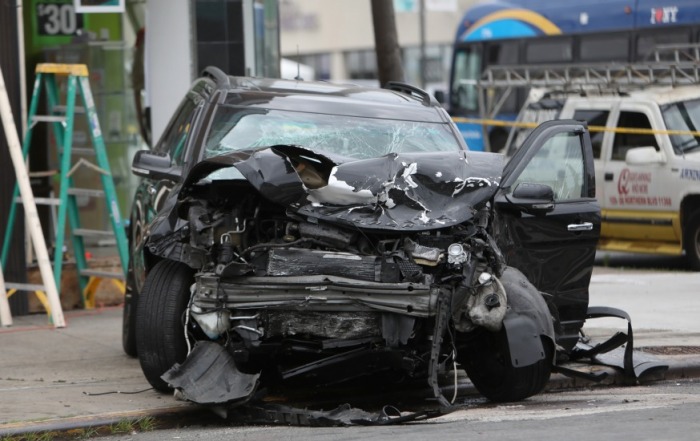
A driver was killed in a crash involving this vehicle on June 13 in Maspeth (Photo: Christina Santucci)
Oct. 7, 2021 By Max Parrott
Traffic deaths across New York City hit a seasonal high under Mayor de Blasio’s tenure this summer with 77 killed in crashes over a three-month period, a new study found.
The striking summer death toll is reflective of overall trends this year. The study by safe streets advocacy group Transportation Alternatives charted how 2021 is on track to be the deadliest overall year of de Blasio’s mayoralty from vehicle collisions.
The study reports that crashes killed 199 individuals citywide through the end of September, making the nine months of 2021 the most fatal of that calendar period under de Blasio.
Advocates say that Vision Zero, the program the mayor rolled out in 2014 with the aim of eliminating all traffic deaths and serious injuries on New York City streets by 2024, has faltered over the pandemic due to insufficient street redesign.
“New Yorkers need a mayor who can prevent cars from killing babies in strollers and essential workers on bikes,” said Danny Harris, executive director of Transportation Alternatives. “With fatal crashes reaching record levels under his term, Mayor de Blasio has squandered the success he achieved on street safety.”
The city reached 200 fatalities for the year on Oct. 2, the earliest point in the calendar year to hit this metric during de Blasio’s tenure. It took until Dec. 20 to reach 200 fatalities in 2018. Other than 2014, the first year of Vision Zero, no other year reached 200 deaths before November.
The study found that Brooklyn has been most affected by the rise in traffic deaths. The total fatalities in the borough through the end of September tally 63 — 40 percent higher than an average of the borough’s year-to-date fatality tolls for all the year’s de Blasio has been the mayor.
Bucking the trendline of the whole city, Queens, has seen a modest reduction in traffic deaths so far this year, with 50 in 2021 through Oct. 3, in comparison with 59 as of this time last year, according to NYPD data. The data shows that in 2021 more fatal crashes took place in the southern part of the borough, where the NYPD’s Queens South Precinct Command had 29 percent increase in traffic deaths, while the northern half of police precincts have seen a near 40 percent decrease in traffic deaths.
Citywide, the report found that the motorist and car passengers accounted for the largest portion of the deaths. Crashes killed 42 motorists and passengers in cars this summer. Through Sept. 30, 88 motorists and passengers have been killed in collisions.
Pedestrians make up another large amount of that total. Summer crashes killed 24 pedestrians. Through September, 90 pedestrians were killed in crashes citywide.
Seven cyclists were killed citywide over the summer, bringing the number who have died through September to 13.
Delivery workers riding bikes, e-bikes or scooters emerged as a particularly vulnerable category of commuter. Crashes have killed 10 of these workers through September, more than the seven delivery workers killed in all of 2020, according to the Workers Justice Project.
In response to its findings, Transportation Alternatives will hold a series of trainings called Your City, Your Voice, in which it hopes to encourage grassroots activism for more safe streets infrastructure. In October, the organization will also host its seventh annual Vision Zero Cities conference.
Its proposed policy solutions center on more resources for street redesign over traffic enforcement. The group also insists that the next mayor must provide more resources to Department of Transportation in order to implement the Streets Master Plan, the program to create a five-year citywide blueprint to improve street safety that was instituted by the city Council in 2019.
One Comment

Further proof that vision zero was more about revenue than safety. They placed cameras in the most profitable areas not where they would be most effective. Secondly there is nothing more effective than a speed bump but a speed bump does not generate revenue so while it is a better tool to decrease speeding and speeders they are barely used across the city.